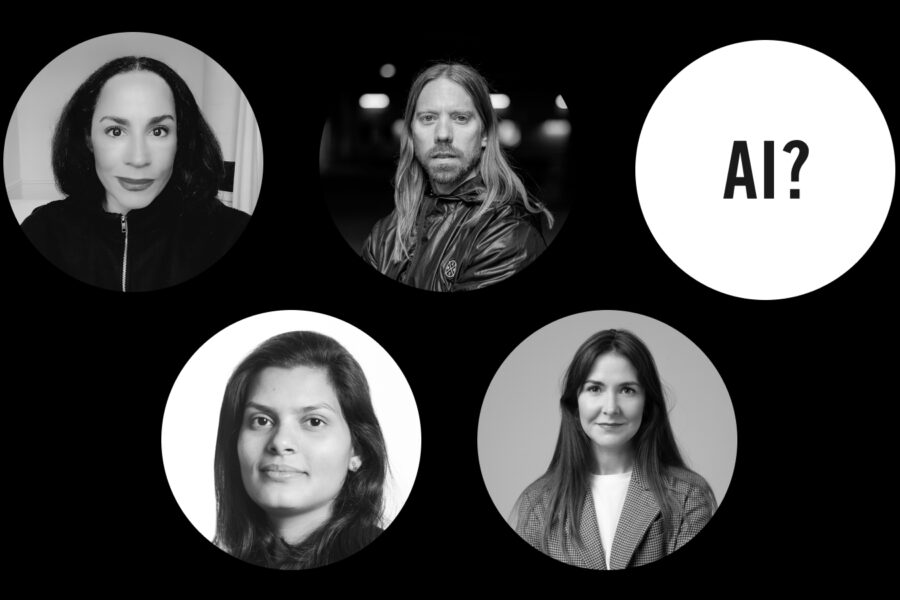
The experts: Everything you want to know about AI in the fashion industry
On the photo above: Jackie Kothbauer, Chandadevi Giri, Nicklas Hermansson & Charlotte Sundåker
New technologies are changing the creative sectors as we know them. But how?
Jackie Kothbauer works as a business futurist and guides business executives and knowledge entrepreneurs to success. She creates future maps of industries, customer behaviours, key moves, and power influencers: ‘If you need to rebirth yourself I’ll be your truthteller.’
Charlotte Sundåker is co-founder and CEO of Planethon, a transformation agency supporting leaders and organisations to thrive within planetary boundaries. According to her, technology in general and AI in particular can serve as an enabler for sustainability as well as unsustainability, which makes it key to use it right.
Nicklas Hermansson is a journalist who started his own media company after spending 20 years with the big players within the Swedish news business. His life now revolves around consuming 2,500 articles, reports, podcasts, and videos every week to identify trends that could become future paradigm shifts. He then shares his findings through keynote speaking, his newsletter NomoFomo Insights, and collabs with the likes of Aftonbladet and SVT.
Chandadevi Giri is a Senior Lecturer in Industrial Economics at the Department of Engineering, University of Borås. In her doctoral thesis, Data-driven AI Techniques for Fashion and Apparel Retailing, she applied data-driven AI techniques to improve decision making related to predicting customer purchase behaviour, sales, and campaign performance in the fashion retail industry. She’s now responsible for the research project’s implementation, and for ensuring collaboration between academic and industry partners.
If we look at AI, what kind of AI technologies should companies know of?
Jackie Kothbauer: Craig Canarick said at SIME Stockholm that everything that can be digital will be digital. That was in 1995. Today? Everything that can be phygital will be phygital. Every physical product and service will come with a smart digital twin (a virtual model designed to accurately reflect a physical object). All other technologies will be deployed within this framework. I don’t just have a personal trainer. He or she is meeting me at the gym, via their app, mail, or my personal fitness tracker. Think multilayer in every relationship you have. If it’s with a human, a brand, a product or a destination doesn’t really matter. Multidimensional is the key. All machines. All factories. All retail. All offices. All homes. All cars. All cities. Every human being will have a digital twin. For healthcare. For online presence. For creating content at work. For testing out dates before meeting up IRL. Same thing with interviewing for a job and other procedures that imply some form of due diligence. AI is at the heart of value creation in this evolution. All the data creates opportunities for exact, unique, real-time personalisation.
Charlotte Sundåker: No one has probably missed the currentLLM (Large Language Models) Generative AI craze and many now use tools like ChatGPT, Midjourney, and DALL·E 2 regularly. However, AI is a lot broader than that, and really about building common sense into machines. LLMs fall under NLP – models to understand natural language which has been around for a while. The rate of use cases based on LLMs will explode since it is so easy to use. I think its important to acknowledge that we are still early in this development, though already now, for instance, Gartner predicts 30% of new pharmaceuticals will be discovered using Generative AI (a type of artificial intelligence that can produce various types of content, including text and imagery) by 2025 already. They also predict that by 2026 generative design AI will automate 60% of the design effort for newwebsites and mobile apps. The same year over 100 million humans will engage robo colleagues (also known as collaborative robots or cobots, robotic systems designed to assist and interact with human workers in shared workspaces) to contribute to their work. By 2027, nearly 15% of new applications will be automatically generated by AI without a human in the loop. This is not happening at all today. New models and technologies for interpreting and describing the world and the future are being developed at an increasing rate. Given the spread of LLMs like ChatGPT the coming generations of the model will be even more integrated in all other tools we use. There are also other AI models that can help companies to be more accurate and efficient like Machine Learning (teaching computers to learn from data), Natural Language Processing (making computers understand human language), Computer Vision (interpreting visual information), and Reinforcement Learning (used in robotics and gaming). Another important aspect companies should be aware of is the emerging AI governance efforts that are being made like the OECD, the EU AI Act, and UNESCO. These governance efforts serve to support the risks that can come with managing AI.
Chandadevi Giri: AI technologies such as computer vision, natural language processing, machine learning, and deep learning are instrumental for the companies to enhance their performance in various areas. Making informed decisions requires an understanding of how AI is applied in fields such as automation, recommendation systems, and predictive analytics. Companies should also invest in IT infrastructure to harness the power of AI effectively.
Nicklas Hermansson: First off there’s Machine Learning. That’s the backbone for a ton of stuff like recommendation systems you see on online stores and even predictive analytics that help companies make better decisions. Then you’ve got Natural Language Processing. That’s what makes chatbots and automated customer service possible. It can even analyze how people are feeling about a brand on social media. Next up is Computer Vision which is super important for things like facial recognition, quality checks in manufacturing, and even self-driving cars. Then you’ve got Reinforcement Learning. That’s really good for solving complex problems, like optimizing a supply chain. And, of course, there’s Generative AI. That’s why we were all talking about the Pope and his Balenciaga coat. Which of course was fake, made by an AI image generator. Generative AI is all about making something new, whether it’s text, images, video, or audio. You’ll see it in things like content generation for websites and creating virtual worlds for gaming. It’s really pushing the boundaries of what we thought machines could create. And since it’s visual and consumer centered, Generative AI is getting most of the attention. To me, it’s the symbol of ’tech sweetness’, the wow phenomena where tech makes us forget everything else.
And where is an good way to start for a company, to get the most out of AI?
Jackie Kothbauer: Discover all the platforms, tools, and services you’re already using where new AI functionality and AI assistants are being integrated. Learning and investing in new tools should always be secondary to taking what you’re already good at and becoming a ninja. Call all the client success managers whose salary you help pay every month. What can they do to unleash your AI potential? Ask them and demand a personalized workshop for you and your team. The second thing to understand is that ChatGPT works like a smartphone – apps create a unique Swiss army-like tool for every user. Understand that logic and the world of AI will become your new Disneyland. Have fun!
Charlotte Sundåker: To start looking at tasks and activities you do that have low risk and typically take a lot of manual work, like different administrative tasks. Personally, I use ChatGPT on a daily basis now, to generate, translate, or re-writing text and it makes the process way faster than before. Based on the actual task at hand you can test different AI technologies, including of course Gen AI. To get the most for companies in general, it’s a good idea to start small and learn what the tools can do for you, be it analysing texts, improving trend forecasts, finding patterns in intense data streams, or generating novel content. Another good starting point is to start thinking about which data you sit with and what you are missing. For the models and algorithms to work you will need good, clean data. Data governance is a field for all companies to start thinking about. You should view AI as a support to what you are doing – especially when it involves a lot of information and processing needs. Computers are far more efficient than humans on those tasks.
Nicklas Hermansson: As always, start small. I’d recommend initiating small pilot projects that can help you understand both the capabilities and limitations of AI in a controlled setting. Once you’ve got a handle on that, the next move should be to consult experts. You really want to tailor the technology to fit your company’s specific needs, and talking to people who’ve been there, done that is invaluable. Now, as you get deeper into this world, you’ll soon find out that data is king. Quality data is absolutely essential for training effective AI models, so companies should invest not only in collecting data but also in cleaning and organizing it. Also, skills are vital. You’ll want to either train your existing staff or, in some cases, bring in new talent with the AI skills needed for your projects to be successful. And since I’m a journalist, I always feel the need to highlight ethical considerations. It’s crucial to address concerns like data privacy and bias right from the get-go. Being transparent and ethical builds trust and is most likely needed if you’re looking for long-term success.
Chandadevi Giri: A company must first determine its unique needs and goals to fully leverage AI. They need to make investments in the acquisition of data, develop AI-driven decision support systems, and cultivate an environment that values continuous learning and adjustment.
How will AI influence the fashion industry and consumption in the coming years?
Jackie Kothbauer: Metaverse mature brands like Nike and forgery-fighting luxury brands like Rolex will expand web3 into mainstream consciousness. Every physical product will come with a digital twin to ensure authenticity and collect fees for secondhand transactions. The circular consumer buys, sells, collects, curates, upcycles, and re-brands the product. AI facilitates this evolution, turning everyday consumers into brand partners. The marketplace will be online, offline, B2B, P2P, marketplace, DTC…many models coexisting. Capturing market data and making smart moves will become more valuable and difficult. The biggest challenge is perhaps to maintain a coherent brand identity. The more people who actively co-create a brand experience the bigger the risk of failure and dilution. How and when will guys like Shein rock web3? When they change their mind about the planet and turn online second-hand into their core business. I can’t wait. What if fifty percent of retail sales were peer-to-peer? When I sell my jeans to you without a retailer touching the garment, we’re there. Swedish Sellpy backed by HM’s AI investment is moving into this model. Their warehouse stocks 3 million pieces. It should be zero. Digital curation and facilitation at the core. Everything else needs to be ‘outsourced’ to their circle of friends, also known as customers.
Charlotte Sundåker: AI can be great to, for instance, help in e-commerce of fashion to consumers to find a great fitting garment that matches your colour preferences and size with the help of numerous techniques, right in your devices camera, connected to the back-end in the fashion retailers systems. It can also help drive transparency in supply chains and promote sustainable production and consumption.
Nicklas Hermansson: I’d say that the potential for AI in the fashion industry is great. Take personalization, for example. AI can really elevate the shopping experience by curating fashion recommendations that are tailored to each person’s unique tastes. That’s nothing new, but we’ve only seen the beginning of the personalized web. If you add computer vision and augmented reality to the mix, it’s pretty clear that the online shopping experience will transform into something else the next couple of years. But the impact goes beyond the customer experience. AI also revolutionizes the back end through supply chain optimization. With AI algorithms, you can dramatically improve demand forecasting and inventory management, which makes the whole system more efficient. And when it comes to trendsetting, machine learning is becoming a game-changer. By analyzing data from social media and other platforms, it can actually predict upcoming fashion trends, offering brands a ‘crystal ball’ to see into the future of fashion. AI can also help the fashion industry reduce waste by identifying more sustainable materials and optimizing the use of resources.
Chandadevi Giri: AI has the potential to completely transform the fashion business by making personalized shopping experiences, sustainable practices, and resilient supply chain management possible. Also, eventually, by providing consumers with personalized recommendations and designers with data-driven insights.
How will it affect the design process in, for instance, fashion?
Jackie Kothbauer: In the same way that streaming turned everyone into a potential artist and TikTok is the new birthplace of film directors. Obviously, everyone will be able to combine generative AI for design and print-on-demand and small-scale production to launch a brand. Is that a good thing? As a result, more people than ever are creators, but a very low percentage can build a long, sustainable, successful career. Running a fashion brand will become more of a hobby than a business. That’s my prediction.
Charlotte Sundåker: Not only can designs be generated much more efficiently, but together with improved AR and VR, designs can be explored in much more detail to customise designs and limit over production. A critical development is that designers will be able to see the Eco-social impacts of different designs before anything is even decided to be manufactured, because ESG data in supply chains will be available to AI models in a totally different way than today. It can also guide designers in material use and full value chain performance for best recycling and reuse.
Nicklas Hermansson: Well, that’s where AI really could bring in some ‘runway magic’. Imagine a designer’s sketchbook that never runs out of ideas, thanks to AI algorithms that can spit out design inspirations based on everything from historical fashion trends to current Instagram crazes. It’s not just about creating new looks; it’s about understanding what people really want to wear. AI can analyze customer data, like what people are pinning, liking, and sharing, and feed that back into the design process. So, instead of designers guessing what might be the next big thing, they’ll have actionable insights to create styles that are more likely to be hits. Designers now have the possibility to transform into Nostradamus. On the contrary, I truly believe that human innovations and low-tech zones will be valued even higher in the future when most things are automated.
Chandadevi Giri: By analysing market data, trends, and consumer preferences, AI will significantly improve the design processes while focusing on consumer-centric features. It will help designers create faster prototyping, less waste, and more relevant and sustainable collections.
AI has become a buzzword within marketing, how can it become a tool to create more efficient marketing?
Jackie Kothbauer: If you work in marketing, you’ve been learning new tools throughout your career. Nothing has really changed. Web, Social, Ecom, apps, AI…what’s next?
Charlotte Sundåker: Indeed it has, and not only in marketing of course. As I mentioned, AI is about building common sense into machines, and as such it can be instrumental in both trend watching and understanding customer behaviour, for strategic marketing as well as executing and measuring campaigns. As with every new tool, it’s important to understand what it actually does, before using AI in marketing. Especially since there are a lot of sensitive copyright and privacy issues connected to novel AI. Not to mention social justice of AI workers, and the climate footprint of running model training in computer centres.
Nicklas Hermansson: It sure has but I’d say it’s legit. AI’s potential in marketing is far from just hype. Imagine having a tool that can sift through mountains of customer data in seconds, helping you identify exactly what your customers want. That’s what AI does. It transforms big data into, hopefully, big insights. And it lets you tailor your campaigns with laser-like precision. But it’s not just analytics. AI-powered chatbots are becoming the customer service agents of the future, since they’re available 24/7, handling queries and even upselling products. And again, AI is great at personalization. It enables you to craft messages that suit every single one of your customer base and resonate on an individual level, making your marketing campaigns not just effective but genuinely engaging.
Chandadevi Giri: Targeted marketing and customisation are two major benefits. AI has a potential to use consumer data to build highly personalized marketing campaigns by adjusting offers, product recommendations, and content to each person’s unique tastes and habits. Another important technique is predictive analytics, which allows companies to analyse historical data to predict trends and find possible leads. Budget allocation and marketing techniques are thus optimized. AI also makes content creation easier. Time and effort may be saved by using AI-powered solutions to generate reports, social media postings, and product descriptions. With AI, A/B testing (a methodology for comparing two versions of a webpage or app against each other to determine which one performs better) and optimization become more effective since algorithms can quickly determine which versions of marketing materials and ad campaigns are doing better. AI streamlines consumer segmentation by classifying clients according to their behavior, demographics, and preferences. This enables more personalized offers and more targeted marketing. Sentiment analysis helps with real-time marketing and plan adaption by tracking social media conversations and customer reviews to determine customer sentiment. Email marketing, SEO, marketing automation, and ad campaign optimization are all impacted by AI, which makes these procedures more efficient and data-driven. In addition, it helps with lead scoring, competitor analysis, ROI evaluation, social media management, customer path mapping, and the generation of advertising content. Overall, AI enables companies to enhance their marketing tactics, interact with clients more successfully, and efficiently provide tailored, pertinent content – all of which lead to improved outcomes.
How do you see this develop in the next coming years?
Jackie Kothbauer: It will change everything as much as the internet did. The internet turned everyone into a publisher. AI creates digital tools, machines, and factories. They create a digital dimension of everything alive which is why multidimensional is the core principle to master.
Charlotte Sundåker: Gen AI will stabilise and likely become commonly available and integrated, like Siri and similar today, but with more business applications. We also see a move ‘back’ into more analytical AI, which is needed to understand the data that AI and companies need to continue developing. The ethical aspects and governance and regulation of AI models will definitely grow in the coming years. It is important to always be aware of the consequences of training models, the possible human rights implications, and how it affects already existing inequalities. IT security and both personal and corporate data protection will also need to keep up with the fast pace of AI generated voice, video, and deep fakes.
Nicklas Hermansson: It’s going to be faster, smarter, and more integrated in our daily lives. But we won’t be talking about it as much. Now, the big question is where we are in the Hype Cycle. Some say the AI revolution has plateaued, while others say we’re just in the beginning. Either way, I’m 100 percent sure that AI will revolutionize two of our biggest challenges today: health care and climate change. I’m also pretty sure that we’ll be talking about and playing with interactive AI a lot in the next coming years. To me the chatbots are the most fascinating part of this revolution. In the near future most of us will have digital assistants that guide us through life, making our decisions, regardless if that’s a good idea or not.
Chandadevi Giri: Continuous development in AI is expected to revolutionize various industries, including fashion, finance, healthcare, and education. It will become more accessible and capable of handling complex tasks, such as product recommendations, stock prediction, and accurate and quick disease diagnosis. AI-driven automation and decision support will become more prevalent in business, streamlining operations and increasing efficiency. Ethical considerations will become more significant, with a focus on fairness, transparency, and accountability.




